
views
X
Trustworthy Source
American Kennel Club
The American Kennel Club (AKC) is a purebred dog pedigree registry in the United States. The AKC advocates for the responsible ownership of dogs and promotes purebred dog events, such as the Westminster Dog Show.
Go to source
The dog's sunny disposition then ensured that it became a firm family favorite. However, while the personality of the Boston terrier is wonderful, its health is not. For example, Boston terriers have a weakness with their eyes due to their size and prominence, which often leads to corneal ulcers, juvenile cataracts, and other eye problems.[2]
X
Research source
It is important that a Boston terrier owner be vigilant about looking for signs of eye trouble, since early intervention could save a dog pain and possibly his sight.
Identifying the Signs of Eye Problems

Look for the signs of corneal ulcers. Corneal ulcers occur when the clear surface of the eye, called the cornea, is severely damaged. Signs that your Boston terrier may have corneal ulcers include the dog rubbing his eye repeatedly and keeping one of his eyes closed at all times. Dogs rub their eyes because corneal ulcers can be very painful and this reduces the pain temporarily. They keep their eyes closed involuntarily to protect the damaged eye. There are two different types of corneal ulcers. One is caused by trauma to the cornea of the dog's eye. This is common in Boston terriers due to the size and prominence of their eyes. The other type of corneal ulcers is caused by a hereditary condition called corneal dystrophy. The second type is particularly hard to treat, in addition to being very painful for your dog. The surface of the eye may lose its shiny appearance. It becomes dull and instead of having unbroken reflections, you may see jagged edges on a reflection, as if looking in a broken mirror.
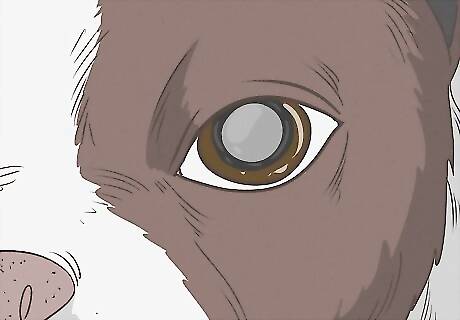
Be on the lookout for the signs of cataracts. Cataracts are another common eye problem for Boston terriers. Cataracts is a condition in which the lens of the eye becomes cloudy and opaque, eliminating the ability for light to get into the eye properly. Cataracts, especially juvenile cataracts that come on very early in a dog's life, can cause the dog to go completely and permanently blind if not caught early. Signs that your Boston terrier might have cataracts include: Blindness: The dog may start finding it difficult to pick up her favorite toy or bump into objects placed in her path. The dog may seem fine on a familiar walk (because she knows the route) but hesitates and hangs back if you visit somewhere she has not visited before. White pupil: When you look directly into the eye you may see a white area at the center of the pupil, a mistiness in the lens, or a white opacity to the lens.
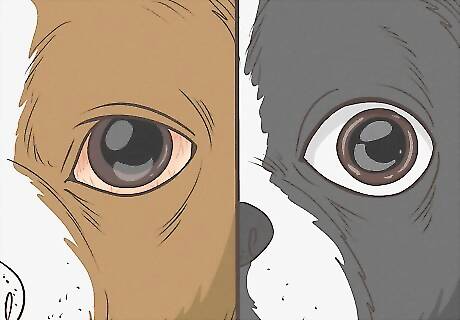
Pay attention to the signs of other eye problems. Boston terriers can get a variety of other eye problems. These include, but are not limited to, cherry eye, retinal atrophy, glaucoma, proptosis (bulging eyes), and eyelash problems. Because the dog's eye problems can vary so drastically, you should be on the lookout for general changes in your dog's eyes, as well as specific symptoms, which include: General eye irritation: The dog may squint, holding the eye partially closed. He may rub his eyes with his paws or on the ground or furniture around your home. Red eye: The white of the eye may have angry red blood vessels streaking over the surface and have a red haze to them. If your dog has cherry eye, his third lid may be red as well. Watery eye: Soreness causes the eye to water, so the dog's cheek may appear wet from tears. Bulging eyes: Proptosis can cause your dog's eye to move out of place, bulging out of his face. This condition is usually fixed with surgery. Different sized eyes: Glaucoma can cause one, or both, eyes to swell. This is because the fluid of the eye is not draining properly, increasing eye pressure and the size of the eye.
Getting a Veterinary Diagnosis
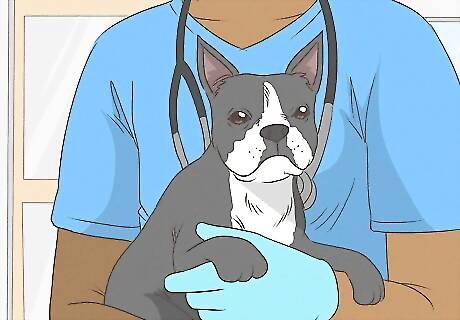
Take your dog to her veterinarian. If you spot any abnormalities, get your Boston terrier checked by the vet immediately. Regardless of the severity of the symptoms you see, if you are in the least suspicious, get the dog checked out. Earlier intervention could reduce the severity of the problem and, in extreme cases, could save your dog's sight.
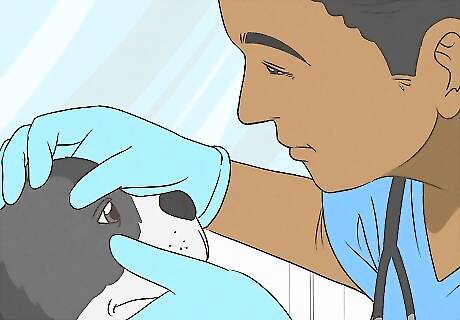
Understand how the vet will assess your dog's eyes. First, the vet conducts a physical examination, paying particular attention to the eyes, the area around the eyes, and the inside of the eye. The vet will look carefully for hairs or whiskers that may be rubbing on the surface of the eye and causing an ulcer. The vet will then use an ophthalmoscope (part light and part magnifier) to examine the surface of the eye, the front chamber, the back chamber, and the retina. This will give the vet information about a cataract, as a cataract will block the light going into the inner part of the eye, making it difficult or impossible to see the retina. To double check, the vet will stand back in a darkened room and shine a bright light directly into each eye from a couple of feet away. Again, the opaque lens blocks light casting a dark shadow on the retina. This confirms that a cataract is present. To check for ulcers, the vet may put a special optic dye, called fluorescein, into the eye. This dye is orange, and in contact with damaged tissue it turns green. An ulcer shows up as a vivid green island on the surface of the orange cornea. This confirms a corneal ulcer is present.

Follow your veterinarian's advice about treatment. Some eye problems can be treated more effectively than others. Unfortunately, in the case of the major problems with Boston terrier eyes, the treatments mainly consist of pain management and delaying blindness for as long as possible. Treatment of cataracts is geared at reducing a sudden inflammation that has occurred within the eye. This may temporarily delay the development of the cataract, but unfortunately it is likely to progress again at some point in the future. Even with prompt treatment, a dog with cataracts may lose his sight. Prepare yourself for this if you have a Boston terrier with cataracts. Treatment of a corneal ulcer can be extremely difficult to do and requires a combination of drops plus a debridement procedure to scrape away devitalized tissue that is preventing healing. Pain relief will also be required to alleviate the discomfort. In some cases, if the issue cannot be fixed the best option for your dog will be the removal of the affected eye.
Understanding Boston Terrier Eye Problems
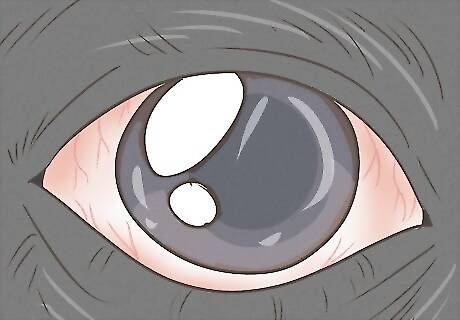
Understand what a corneal ulcer is. The cornea is the transparent capsule on the front portion of the eye globe, through which light passes to reach the lens and pass onward to the retina. Think of it like a clear skin over the eye (that is the full thickness of the globe). The cornea is actually made up of stacks of clear cells, arranged in layers, much like bricks in a wall. An ulcer is like a burst blister on the skin of the eye or an erosion or crater sitting on the surface of the eye. In the case of the Boston terrier, the ulcer may develop because of a problem called corneal dystrophy. This is a problem where the glue holding the cells together fails, like not enough mortar between the bricks. This allows sheets of cells to lift up and peel away. Corneal ulcers are painful. If they erode too deeply the eyeball is severely weakened and it can burst, causing the dog to lose that eye.
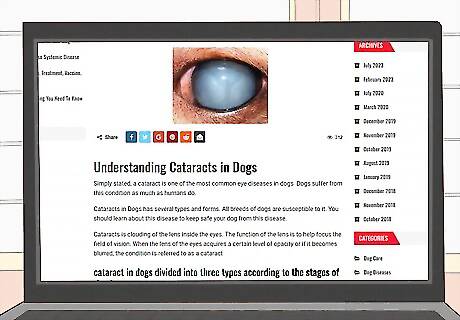
Learn about hereditary cataracts. A cataract refers to a cloudiness of the lens. The lens is the structure which focuses light on the retina. It is a transparent sack of jelly and sits just behind the colored part of the eye, the iris. It is a genetic condition that can cause a cataract to develop at as young as 12 months of age. Juvenile cataracts can develop distressingly quickly, sometimes in as little as 24 hours. If the cataract is very dense, you see a bright white object sitting in the middle of the eye, where the black pupil normally is. It is thought that one in 10 Boston terriers will suffer from this condition during their life. Sudden formation of a juvenile cataract is sometimes associated with inflammation within the eye, so the eye is sore and inflamed. If the cataract is very dense it blocks the passage of light, and although the retina is healthy, the dog is blind because the light is prevented from penetrating that deep into the eye.

Understand how breeding practices can increase or decrease the chances of eye problems. Part of the reason that Boston terriers, and other purebred dogs, have so many eye problems is because dogs that have these problems already are being bred with each other. It increases the likelihood of these conditions if one or both parents have a genetic condition already. Fortunately, if good breeding practices are observed (for instance not breeding dogs with these conditions) the issues could be reduced greatly. For example, there is now a genetic screening test available for juvenile cataracts. In the case of juvenile cataracts, prevention is better than a cure. If all breeding stock were screened, and only negative dogs were bred, the problem could be brought under control. When you adopt a dog from a breeder, as to see the medical records of the dog's parents. If they have had proper veterinary care and have been screened for eye problems, then the chances that your prospective dog will have eye problems are much lower.



















Comments
0 comment